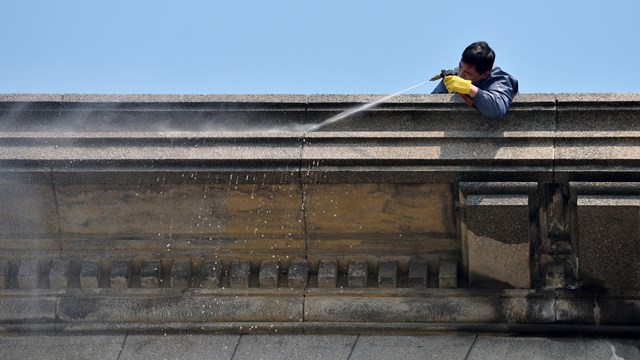You've got to hand it to city plants. They squeeze themselves into the tightest of spaces, and each day they battle pollution and smog, get stepped on (or worse, thanks to the city's dog owners) more times than they'd like to count. In short, they're a lot like us—and like us, they need a certain amount of care and tending in order to thrive in the concrete jungle.
Well-thought out and properly maintained plantings and landscaping clearly improve the appearance (and therefore the value) of a building. With some planning and a little advice from the experts, you can get the most out of your landscaping choices and avoid costly mistakes.
The Threats
Plants grow from the bottom up, obviously, and suffer most when their roots are damaged—something that can happen easily in an urban environment. Justin Rawson has been the managing arborist at Almstead Tree & Shrub Care Company in New York City for the past four years, and says that the biggest threats to city greenery happen at the root.
"The absorption of water and nutrients through the roots is essential to the biological functions that occur through photosynthesis up in the canopy," he says. "Damage, such as severe compaction, root cutting for new sidewalks, and chemical damage from salting or street cleaners reduces the capability of root masses to efficiently absorb nutrients and pump them to the top of the plant."
And that's just the man-made damage. "After that," Rawson adds, "drought stress and extreme climate swings such as warm winters, lack of rain, or cold snaps late in the season can all add up and kill off a plant or tree that's stressed already."
Jane Perry, author of Nature In Design,a manual for anyone looking to grow healthy plants at home, notes that once the plant's roots are safe, the plant's next biggest threat is the amount of light it gets.
"As all plants make their own food through photosynthesis, using light, water, and carbon dioxide to make the carbohydrates needed for all the internal functions that go on in a plant through out the day," says Perry. "If not enough light is available to the plant for what it needs to keep it healthy and growing, it will weaken and begin to perish quickly."
In a city of skyscrapers, windows that face other walls, and precious little yard space, lack of sunlight is a very real threat to plants, both indoor and outdoor. Because many areas of your building might not be bathed with prime light, it's important to choose plants that will do best with the light available.
Plant Number One?
Or Number Two?
Though it's an uphill battle at times, one thing that New York plants have going for them is their abundance within markets and garden centers. New Yorkers love their greenery, and there's no dearth of helpful green-thumbers out there to help your building's garden or design committee make the right decisions. For Perry, the best advice is usually right around the corner. "[I prefer] going to a local garden center rather than a chain store," she says. "Customers get the best information as to what plants will do best in the area where they want to plant. This is exactly what landscapers do to make sure they are planting correctly for a given site. If the garden center is reputable, the sales person will also ask about soil types and hydration, like how much water is available to the plant without extra watering. All these questions help the sales person to narrow the plants that will do best in the chosen area."
Richard Heller is chief executive officer of Greener By Design, a landscaping company based in Pelham, and knows a thing or two about proper plants for city environments. He has two words to describe what works best: tough plants.
"Most common are taxus, euonymus, bamboo, juniper, holly, hosta, astilbe, pachysandra, and ivy," says Heller. "There are many more hardy plants, but their price tends to reduce their use."
Heller admits that some of the hale and hearty plants that do best in an urban setting lack a certain showy exoticism, but that's no reason to ignore their usefulness or appeal. "None of the above examples are particularly exciting on their own, but they can be when used correctly," he says.
When it comes to what kinds of trees to plant out front or in a garden space, Rawson says buildings have several options, as long as the tree meets a certain criteria.
"Trees that are used to low-oxygen environments and are tolerant of salts, damage from trucks, pollution, and urban heat survive best," he says. "These trees include many hybridized species, which are now widely planted the world over, such as London Planes—which are a cross between a Sycamore and a Turkish Plane. There's also the Thornless Honey Locust, which is the fastest at generating roots of any approved street tree we know of, and the Aristocrat Pear, a successor to the Bradford Pear and tolerant of salt damage and heavy urban stress."
Rawson makes an important point; even if you don't use a professional landscaper to actually plant the trees or plants you select, it's very important to find someone qualified to ensure that what you want to plant (be it trees, flowers, or shrubs) is approved for planting by the city. Certain species are prohibited due to the environmental risks they might pose, their susceptibility to disease or pests, aggressive root systems that can damage paving and building foundations, or other troublesome tendencies—like stinky Ginkgo berries, for example.
Getting It Done
Long before the first planting is complete, a building must make some serious decisions: What do we want to plant? Who will do the planting and maintain it? How much will it cost? According to Heller, once the decision has been made to improve the look of your building with landscaping, selecting a professional landscaping company is likely the most crucial decision in the process.
Heller also advises buildings not to shy away from a firm that charges a fee for its initial design proposals. "The starting point for any board is working out a strong design by a company that understands architecture and has strong plant knowledge," he says. "Generally, companies that design for free do so many designs they don't sell, they have to spit the designs out quickly, and that can water down the quality. Working for free is generally a poor incentive for quality work of any kind. Paying for design work almost always yields better designs."
Heller feels that the cost incurred at the design stage is a kind of insurance for a committed landscaper. "Design building companies like ours will do the design at cost to cover our expenses, because we want to install the garden. This [approach] can save buildings money over landscape architects who charge more, but may have less experience with urban plantings."
Another big benefit of working with a qualified arborist or landscaper is that they can actually tell the future. You don't want plants and trees that just look good this spring—you want plants and trees that will still look good in the springtime of 2020.
Rawson says when new clients come to him, he asks them about their long-term goals and expectations. "[We discuss] the type of tree they want in 20 years, whether that be a flowering tree about 15 feet high or a large London Plane that reaches the top of a brownstone. The most important thing is that the client is educated in how a tree must be maintained and cared for to get from point A: a small sapling, to point B: a healthy mature street tree."
Rawson says the job of a good landscape designer is to know the longevity of trees in a place like New York City. "You just can't plant it and walk away. It's a living thing, and must be cared for—specially in a hostile urban environment."
Greening Your Thumb
Once all the planting has been done, your residents and committee members will wait with bated breath for the first flowers to appear and the shrubs to flourish. It's almost like opening a surprise package. That's all very well—and yes, the landscaping is there to be enjoyed—but since plants are living, breathing things, who will tend to them once they've arrived? Most landscaping companies offer continuing maintenance and care as part of the job. Some managers solicit other contractors to maintain the green. Still other ambitious buildings give it a try themselves—sometimes with mixed results.
"Anyone can cultivate a green thumb if they are willing to take the time to research what they want and are willing to put in the time to care for the plants the way they need to be cared for," says Perry, adding that that doesn't mean you'll know everything. "Going to a professional and asking questions is the beginning to success."
And if a zealous would-be gardener in your building fails miserably when they try to grow a bamboo meditation garden in your adjacent lot, all may not be lost. "It's not always guaranteed that a plant will thrive in a certain area—even though all the specs say it will," says Perry. "Most reputable garden centers will stand behind their products. If they recommend a certain plant and it does not do well, contact the place where you purchased it, and they should replace it. Or, if it is possible to help the plant, they should do so. Sometimes a customer won't water a plant enough because of lack of rain, or maybe it needs some nutrient that is missing in the soil; a good garden center will do all they can to help make things right."
Heller believes it's not always best to leave large exterior landscaping upkeep to someone without serious experience.
"If you want it to look good, find a trusted professional. Plants need three things to thrive: proper light, soil mix, and water," he says. "Soil needs to be tested and remediated regularly in urban environments due to pollution, dogs, acid rain, and salt or ice melt. Insufficient light, water, or soil that has the wrong Ph and/or nutrients will stress the plant material. Stress leads to illness, insects and death, so unless someone on your building staff has been trained in horticulture and knows plants, we would always recommend outsourcing the maintenance. Urban environments are very stressful to plants, and that makes it harder for amateurs."
Protect & Beautify
Getting tough-but-pretty plants and trees into the picture at your building can be a costly process. That cost varies widely, depending on the size and scope of the project, your location, and the company you choose to do the work. If the estimates coming in are making your board a little queasy, consider the benefits to your building itself—and even the passersby.
"[Plants and trees] offer a pleasant aesthetic relief from the normal concrete we see in day-to-day life," says Rawson, but that's certainly not where the benefits end. "Houses on tree-lined blocks usually sell for more than houses in similar areas without trees," he continues. "They also cool buildings during the summertime, decreasing the cost of air conditioning. They help to filter the air, keep the under story shaded, and absorb water from the ground."
Taken together, that's a pretty strong case for greening your building's exterior spaces, whether that's just a couple of planters and a tree pit out front, or a lush private garden in the back or on the roof. Whatever your building's character or budget, it's vital that you work with your chosen landscaping professional to pick the right plants for the job—ones that will be beautiful to look at, while being robust enough to thrive in their urban surroundings.
Mary Fons is a freelance writer living in Chicago, Illinois and a frequent contributor to The Cooperator.







2 Comments
Leave a Comment